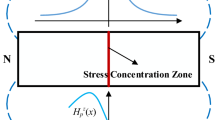Abstract
Metal magnetic memory effect, induced by applied stress under the excitation of the geomagnetic field, has attracted a lot of attentions due to its unique advantages of stress concentration identification and early damage detection for ferromagnetic materials. To further investigate the regularity of magnetic memory signals in the fatigue crack propagation process under the dynamic bending load, the surface magnetic field intensity \(H_{p}(y)\) of ferromagnetic structural steel was measured throughout the dynamic three-point bending fatigue tests; variation of \(H_{p}(y)\) and its maximum gradient \(K_{max}\) were studied; meanwhile the possibility of using \(K_{max}\) to predict the fatigue crack propagation was discussed. The results showed that \(H_{p}(y)\) was relatively stable at different loading cycles and its maximum value appeared at the fatigue crack area before the specimen fractured; instead the \(K_{max}\) increased exponentially with the increase of loading cycles, and an approximate linear relationship was found between \(K_{max}\) and crack length 2a. The cause for this phenomenon was also discussed.







Similar content being viewed by others
References
Yi, S., Eripret, C., Rousselier, G.: Influence of defect shape on damage evolution and fracture behavior of ductile materials. Eng. Fract. Mech. 51, 337–347 (1995)
Wang, Q.Y., Berard, J.Y., Rathery, S., Bathias, C.: High cycle fatigue crack initiation and propagation behaviour of high strength spring steel wires. Fatigue Fract. Eng. Mater. Struct. 22, 673–677 (1999)
Doubov, A.A.: A study of metal properties using the method of magnetic memory. Met. Sci. Heat Treat. 39, 401–405 (1997)
Wilson, J.W., Tian, G.Y., Simon, B.: Residual magnetic field sensing for stress measurement. Sens. Actuators A 135, 381–387 (2007)
Dong, L.H., Xu, B.S., Dong, S.Y., et al.: Variation of stress induced magnetic signals during tensile testing of ferromagnetic steels. NDT E Int. 41, 184–189 (2008)
Dong, L.H., Xu, B.S., Dong, S.Y., et al.: Stress dependence of the spontaneous stray field signals of ferromagnetic steel. NDT E Int. 42, 323–327 (2009)
Leng, J.C., Liu, Y., Zhou, G.Q., et al.: Metal magnetic memory signal response to plastic deformation of low carbon steel. NDT E Int. 55, 42–46 (2013)
Shi, C.L., Dong, S.Y., Xu, B.S., et al.: Metal magnetic memory effect caused by static tension load in a case-hardened steel. J. Magn. Magn. Mater. 322, 413–416 (2010)
Wang, Z.D., Yao, K., Deng, B., et al.: Quantitative study of metal magnetic memory signal versus local stress concentration. NDT E Int. 43, 513–518 (2010)
Roskosz, M., Gawrilenko, P.: Analysis of changes in residual magnetic field in loaded notched samples. NDT E Int. 41, 570–576 (2008)
Shi, C.L., Dong, S.Y., Xu, B.S., et al.: Stress concentration degree affects spontaneous magnetic signals of ferromagnetic steel under dynamic tension load. NDT E Int. 43, 8–12 (2010)
Leng, J.C., Xu, M.Q., Xu, M.X., et al.: Magnetic field variation induced by cyclic bending stress. NDT E Int. 42, 410–414 (2009)
Li, J.W., Xu, M.Q., Xu, M.X.: Investigation of the variation in surface magnetic field induced by cyclic tensile–compressive stress. Nondestr. Test. Eval. 27, 1–7 (2012)
Sánchez-Beitia, S.: Calibration of the X-ray diffraction technique for stress quantification in metallic (steel) structures. Exp. Mech. 51, 1301–1307 (2011)
Monin, V.I., Gurova, T., Castello, X., Estefen, S.F.: Analysis of residual stress state in welded steel plates by X-ray diffraction method. Rev. Adv. Mater. Sci. 20, 172–175 (2009)
Jiles, D.C.: Theory of the magnetomechanical effect. J. Phys. D 28, 1537–1546 (1995)
Chen, Y., Kriegermeier-Sutton, B.K., Snyder, J.E., Dennis, K.W., McCallum, R.W., Jiles, D.C.: Magnetomechanical effects under torsional strain in iron, cobalt and nickel. J. Magn. Magn. Mater. 236, 131–138 (2001)
Yang, E., Li, L.M., Chen, X.: Magnetic field aberration induced by cycle stress. J. Magn. Magn. Mater. 312, 72–77 (2007)
Guo, P.J., Chen, X.D., Guan, W.H., Cheng, H.Y., Jiang, H.: Effect of tensile stress on the variation of magnetic field of low-alloy steel. J. Magn. Magn. Mater. 323, 2474–2477 (2011)
Miyazaki, T., Jin, H.M.: The physics of ferromagnetism. In: Springer Series in Materials Science, vol. 158, Springer, Berlin (2012)
Gong, W.Y., Wu, Z.M., Lin, H., Yang, X.L., Zhao, Z.J.: Longitudinally driven giant magneto-impedance effect enhancement by magneto-mechanical resonance. J. Magn. Magn. Mater. 320, 1553–1556 (2008)
Jie, D., Qian, Q., Li, C.A.: Numerical Calculation Method and the Engineering Application in Fracture Mechanics. Science Press, Beijing (2009)
Jakobsen, B., Lienert, U., Almer, J., et al.: Direct observation of strain in bulk subgrains and dislocation walls by high angular resolution three-dimensional X-ray diffraction. Mater. Sci. Eng. 483–484, 641–643 (2008)
Sarkar, A., Mukherjee, P., Barat, P.: X-ray diffraction studies on asymmetric-call broadened peaks of heavily deformed zirconium-based alloys. Mater. Sci. Eng. 485, 176–181 (2008)
Mendibide, C., Steyer, P., Esnouf, C., Goudeau, P., Thiaudi’ere, D., Gailhanou, M., et al.: X-ray diffraction analysis of the residual stress state in PVD TiN/CrN multilayer coatings deposited on tool steel. Surf. Coat. Technol. 200, 165–169 (2005)
Jakobsen, B., Poulsen, H.F., Lienert, U., Almer, J., Shastri, S.D., Sørensen, H.O., Gundlach, C., Pantleon, W.: Formation and subdivision of deformation structures during plastic deformation. Science 312, 889–891 (2006)
Acknowledgments
This work is financially supported by the National Natural Science Foundation of China (51135004, 50905052) and Program for New Century Excellent Talents in University of Ministry of Education of China (NCET-12-0837).
Author information
Authors and Affiliations
Corresponding author
Rights and permissions
About this article
Cite this article
Huang, H., Jiang, S., Liu, R. et al. Investigation of Magnetic Memory Signals Induced by Dynamic Bending Load in Fatigue Crack Propagation Process of Structural Steel. J Nondestruct Eval 33, 407–412 (2014). https://doi.org/10.1007/s10921-014-0235-y
Received:
Accepted:
Published:
Issue Date:
DOI: https://doi.org/10.1007/s10921-014-0235-y




